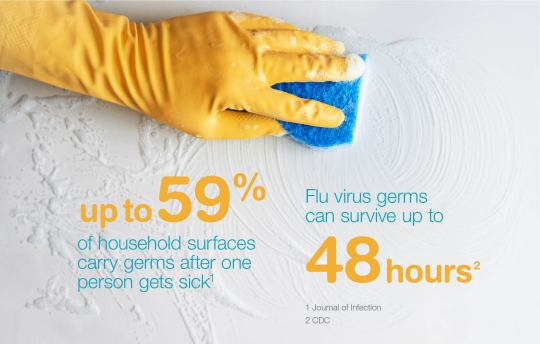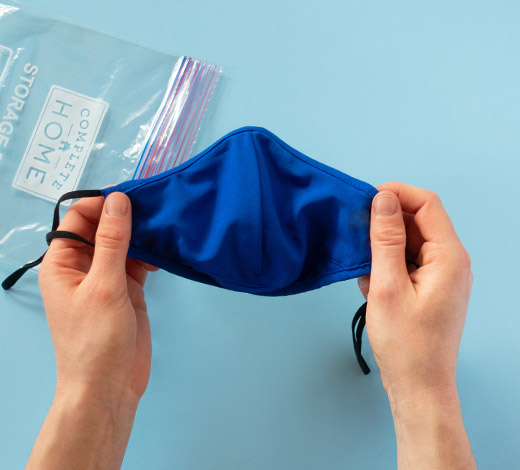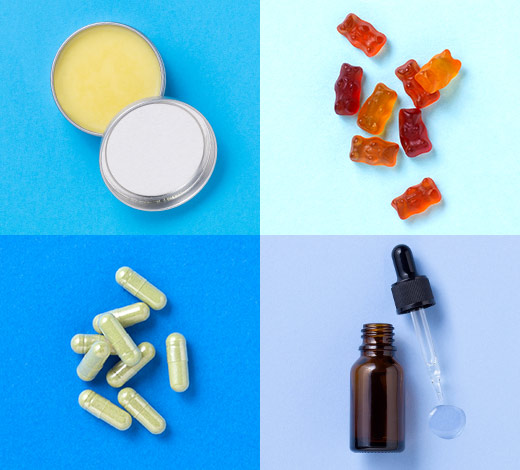
The flu virus can live on surfaces for 48 hours—potentially infecting anyone who comes in contact with the germs, according to the CDC.
Sick people are contagious from the day before their symptoms
begin and can develop for up to 7 days, according to the CDC. Germs are spread through coughing, sneezing
and touching things like doorknobs, light switches, phones, remote controls and
handles on appliances and drawers.
Fortunately, CDC says flu germs are pretty fragile. You can help kill them by
sufficiently cleaning and disinfecting common areas—as long as you use the
right techniques and equipment.
Clean Safely
Protect yourself while fighting against flu germs by
paying close attention to product warnings and directions. Some labels may
suggest you use of gloves or eye protection, especially when working with strong
chemicals like bleach.
Don’t mix cleaners
and disinfectants unless the labels say it’s safe to do so. CDC advises that if some products are combined (such as chlorine bleach
and ammonia cleaners), they can cause serious injuries—even death.
Wash or Toss Common Items
Wash rags, bath towels, bed sheets and
clothes that the sick person could’ve come in contact with, in case germs are
still embedded in the fabrics.
Toothbrushes can also be home to all sorts of
bacteria and viruses. Throw the sick person’s toothbrush into boiling water for
a minute, or soak it in alcohol-based mouthwash. Otherwise, throw it out and
buy new ones for the family.
Pay
close attention to items in your kitchen—it’s usually the germiest place in the
house. Don’t use a sponge when you’re disinfecting, since germs can live inside
old sponges.

Clean, Disinfect, Sanitize & Repeat!
Clean all
surfaces with an EPA-registered product that both cleans (removes germs) and
disinfects (kills germs). Depending on the product, the cleaning procedures may
differ. For example, disinfecting cleaners usually need to soak the surface for
an extended period of time. Read the directions before you start scrubbing.
Rinse surfaces water, and follow with an EPA-registered
disinfectant to help kill germs. If
an EPA-registered disinfectant is not available, CDC advises to mix your own fresh chlorine
bleach solution:
- Add 1 tablespoon of bleach to 4
cups of water. For a larger supply of disinfectant, add ¼ cup of bleach to 1
gallon (16 cups) of water. - Apply
the solution to the surface with a cloth. - Let
it stand for 3–5 minutes. - Rinse
the surface with clean water.
Wipe commonly used
electronic items such as phones and computers with disinfectant wipes, and use
a Q-tip on hard-to-reach areas like between buttons. You might need to use
multiple wipes to ensure the disinfectant is working on the surfaces for the
right amount of time. Just make sure you’re not harming your electronics by
getting the liquid in the wrong spot.
Don’t Overdo It
Although giving
your entire house a good scrub is important in trying to remove flu germs,
don’t do anything over the top, such as wiping down walls and ceilings, spraying
air deodorizers or fumigating. Not only is this unnecessary, CDC says these processes can irritate eyes, noses, throats and skin;
aggravate asthma; and cause other serious side effects.
Also, cleaning isn’t the only way to stop the spread of flu
germs. It’s also important to wash your hands multiple times a day, and be
careful not to share foods or utensils with those who might be sick.
Clinically reviewed on 3/10/2020
Sources
“How Flu Spreads.” Centers for Disease Control and Prevention, Centers for Disease Control and Prevention, 27 Aug. 2018, www.cdc.gov/flu/about/disease/spread.htm.
“How To Clean and Disinfect Schools To Help Slow the Spread of Flu.” Centers for Disease Control and Prevention, Centers for Disease Control and Prevention, 31 July 2018, www.cdc.gov/flu/school/cleaning.htm.
“How To Clean and Disinfect Schools To Help Slow the Spread of Flu.” Centers for Disease Control and Prevention, Centers for Disease Control and Prevention, 31 July 2018, www.cdc.gov/flu/school/cleaning.htm.


